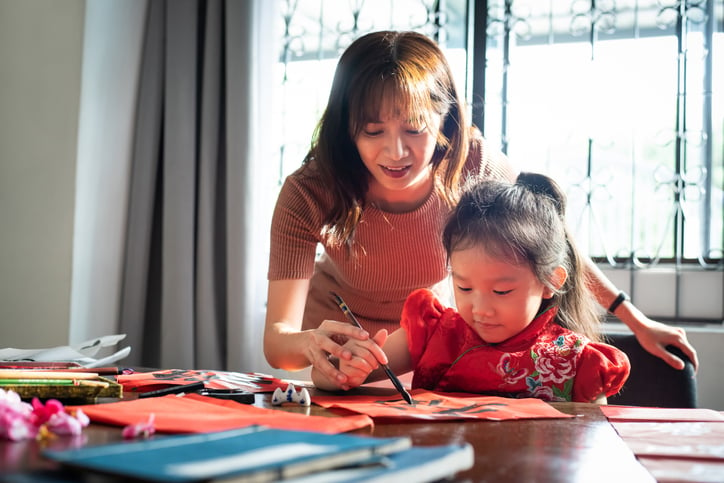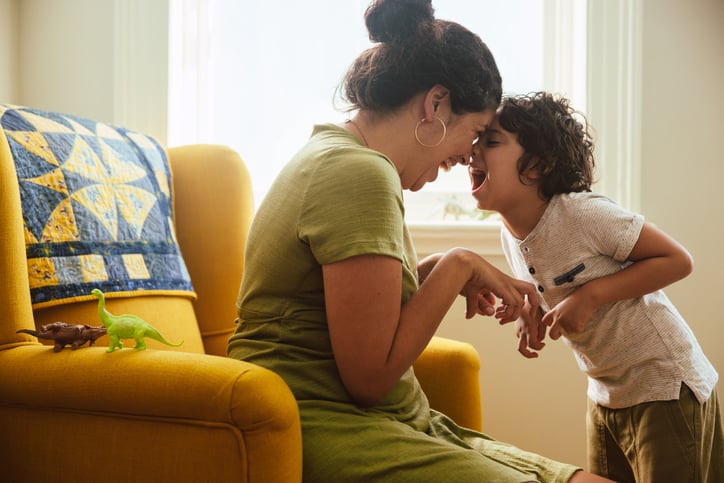What is Parent-Child Interaction Therapy (PCIT)?
PCIT is an evidence-based treatment for young children with behavioral problems and can be an effective intervention for children with autism.
There are several different interventions that have been used to treat autism that are termed “naturalistic” because they work within a child’s environment, usually following the child’s lead in the interaction, to affect behavior change. Parent-Child Interaction Therapy (PCIT) was not originally developed for children with autism, but rather for helping parents to manage disruptive behavior. However, given that the symptoms of autism include behavioral rigidity and inflexibility, this can look like any other child’s stubborn behavior and can result in tantrums, aggression toward self and others, and defiance. Importantly, the foundation of the behavioral strategies utilized in PCIT is the same across any diagnosis. In fact, children don’t need a diagnosis at all to receive PCIT, although sometimes one is required for insurance coverage. The treatment is based on the behaviors addressed rather than any specific diagnosis.
Parent Coaching
PCIT is referred to as a parent coaching treatment. This means that for the majority of the treatment, the therapist is in one room, and the parent and child are in another. The therapist coaches the parent through different interactions by speaking through an earpiece that the parent wears.
PCIT is divided into two phases, called Child-Directed Interaction (CDI) and Parent-Directed Interaction (PDI). In CDI, the parent learns strategies for connecting with their child by meeting them where they are, and following their lead, in play interactions specifically. The therapist coaches the parent on how to do this using specific categories of statements that the parent is encouraged to avoid because they correct the child or actively direct their behavior, and other statements they are encouraged to use more often because they increase positive behaviors.
Specifically, parents are taught during play with their children to avoid asking questions (e.g., “What does the cow say?”), giving commands (e.g., “Let’s build a tower with the blocks!”), or using critical or corrective statements (e.g., “That’s not the way that goes.”). These statements tell the child the parent is the leader and decrease child-developmental growth during the play. For children who are particularly inflexible, these statements can also lead to conflict or avoidance of play interactions altogether.

PRIDE: “P” for Praise
Parents are encouraged to use skills that make an acronym referred to as PRIDE. P stands for praise or labeled praise specifically. Instead of giving non-specific praise, like “Great job!” or “Awesome job!” parents are instead coached to be specific about the wording of their praise. For example, “I love how you’re using your manners!” These labeled praises allow the child to know specifically which behavior was completed correctly, so they can do it again more consistently to receive the same praise and positive attention.
PRIDE: “R” for Reflect
The R in PRIDE stands for Reflect. Parents are encouraged to repeat back to a child what they have said, to encourage language and communication, as well as to communicate to the child that they are paying close attention and are interested in hearing more. This is complicated for some children with ASD, particularly for those with echolalia or non-communicative repetition of other’s speech. When this type of speech occurs in PCIT, parents are encouraged to reflect mostly communicative speech, and if a child’s language is mostly echolalia, to reflect only once and then move on to other language and extend the echolalia into a functional communication. For example: Parent: “I’m rolling you the ball.” Child: “Ball!” Parent: “Right, ball! You caught the ball!”
PRIDE: “I” for Imitation
The I in PRIDE stands for Imitation. Although when we think of imitation we often imagine parroting the child, the goal of this imitation is more about joining the child in their activity, at their pace, following their goals for the interaction. This is sometimes tough with play that seems to lack a goal or direction, which is common for children who enjoy more cause-and-effect play (filling up containers and dumping them out) or repetitive sensory-seeking play like shaking toys or spinning wheels.
For children earlier in their social play development whose goal for play is less clear, we recommend parents continue to follow the pace of the play (i.e., if the child plays slowly with the toys, the parent manipulates the toys slowly as well). However, the goal is also to help the child advance through modeling to the next stage of play development. In order to accomplish this, the parent does what the child is doing within their comfort level (e.g., filling a truck and dumping it out) and then adds a small piece onto the play as the child will allow (i.e., back out of a change if the child protests at this stage of the treatment). For example, the parent may dump out the truck and then drive it over to a different toy to fill it up. Driving the truck is a play behavior the child may not currently do, but modeling it introduces a new way to use that toy.

PRIDE: “D” for Describe
The D in PRIDE stands for Describe. Parents using this skill verbally narrate their child’s play. For example, when a child is playing with trains, the parent narration might say:
“You picked up the track and connected it to the other track. Now it looks like you’re trying to make a circle with the tracks. I see you put the train on the tracks and now you’re pushing it around the track.”
Describing a child’s play accomplishes many things. The parent is modeling language that accompanies the child’s current behaviors. Language is a very abstract thing for children and is thus more difficult for children with ASD because of difficulty understanding the abstract in general. So connecting abstract language with concrete actions helps it to stick. Additionally, describing a child’s actions focuses attention on the process of an activity, rather than the result. This is especially important for children who are focused on creating a perfect result (e.g., drawing or building) because they can often become frustrated if their result is anything less than perfect. Often, however, when parents demonstrate explicit positive attention on the steps that get to the end (i.e., say: “Now you’re drawing the lines.” And avoid saying: “Try again on that line; it’s crooked.”), children can also learn to focus on the steps rather than the outcome. Describing also helps children hold their attention on one task because the parent is modeling continued attention to that task.
PRIDE: “E” for Enjoy
The E in PRIDE stands for Enjoy. The goal is for the parent to create an environment where both parent and child can focus on their interaction with one another. There are two aspects of this that are particularly important for children with ASD. The first is for the parent to sit face-to-face with the child. If the child moves behind or to the side of the parent, the parent should move as much as it is feasible to sit face to face, which allows for more natural dyadic interaction to occur, because, if eye contact is not common, sitting this way the child may accidentally look toward the parent more often.
The second aspect of enjoyment that is important for parents of children with ASD is for the parent to modulate the level of stimulation/enthusiasm to meet the child’s level of arousal. If the child is calm, quiet, and not interacting much, the parent should increase enthusiasm and express excitement to get the child more engaged in the play. On the other hand, if the child seems overstimulated, frustrated, or fidgety, the parent should decrease the volume, energy level, and pace of play so the child can regulate and engage calmly in the play again. Essentially you are modeling regulation for the child to help them find that happy medium where they have the energy and space to play.

5 Minutes a Day
PCIT therapists recommend that parents schedule five minutes of play each day with each of their children. It’s important to include all children in the house in this scheduling, so you’re not communicating that you’re singling out one child or another. It’s also important that this time occur whether or not the child had a difficult day before the play time, as it’s not meant to function as a reward in itself.
If you’re reading this and you’ve tried this type of play, let us know in the comments what you thought. If you’ve never tried it before, give it a shot and then comment about how it went.
We hope you enjoyed the information in this article. STAGES® Learning also offers free downloadable resources to support teaching and learning with individuals with autism. Start with our free Picture Noun Cards and see our collection of other downloadable resources here!

Abby Peskin
Dr. Abby Peskin is a child psychologist from Miami, with a training emphasis in the treatment of disruptive behavior disorders in young children, focusing on intervention and assessment for Autism Spectrum Disorder. Her clinical background consists of specialized training in the diagnosis and treatment of both Autism and anxiety, including group, individual, and school-based treatment. She was drawn to child psychology because she genuinely loves working with children, and nothing delights her more than watching parents and their children get closer, watching their relationship get less stressful, and seeing parents increase their confidence and realize what amazing parents they can be.




